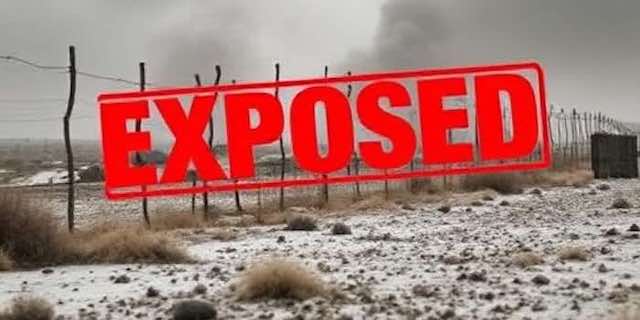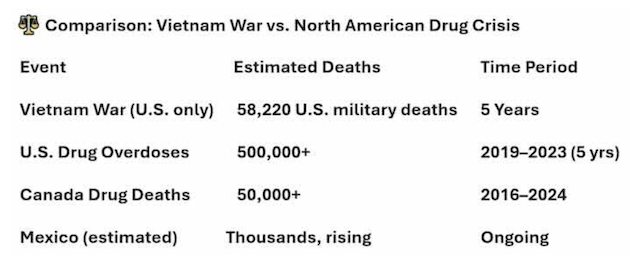One of the largest and most expensive secret wars in the history of these nations is targeting Canada, Mexico, and the US. Not only are lives and ruined communities at stake, but no one seems to be able to stop the carnage.
 Native American communities on reservations, particularly those situated along borderlands. From Arizona to Montana, and even into territories that straddle the U.S.-Canada line, drug cartels have discovered both opportunity and immunity on tribal lands, and American Indian communities are paying the price.
Native American communities on reservations, particularly those situated along borderlands. From Arizona to Montana, and even into territories that straddle the U.S.-Canada line, drug cartels have discovered both opportunity and immunity on tribal lands, and American Indian communities are paying the price.
Tribal lands are in the crosshairs of cartels, and the cartels are winning! The Tohono O’odham Nation in southern Arizona sits directly on the U.S.-Mexico border, and for years, it has faced a growing threat from Mexican drug cartels. Their 2.8-million-acre reservation, about the size of Connecticut, spans nearly 75 miles along the border and has become a key trafficking corridor for cartels smuggling drugs and people into the United States.
According to Verlon Jose, chairman of the Tohono O’odham Nation, tribal police now spend nearly half their time on border-related issues, from drug smuggling to migrant enforcement. The tribe allocates $3 million of its funds annually to protect its lands, money it cannot afford to lose. Cartels have even turned environmental sabotage into a tactic: funneling large groups of migrants into the reservation to overwhelm tribal law enforcement, leaving behind environmental damage and diverting attention from their true goal of smuggling high-value narcotics.
The numbers are staggering. In 2020, the tribe helped seize 140 pounds of heroin and 20 pounds of fentanyl powder tied to a Sinaloa cartel cell. But the trafficking hasn’t slowed. In 2023, thousands of illegal migrants camped out on their land, leaving trash, cutting down trees for firewood, and straining limited tribal resources.
Native American communities on reservations, particularly those situated along borderlands. From Arizona to Montana, and even into territories that straddle the U.S.-Canada line, drug cartels have discovered both opportunity and immunity on tribal lands, and American Indian communities are paying the price.
Tribal lands are in the crosshairs of cartels, and the cartels are winning! The Tohono O’odham Nation in southern Arizona sits directly on the U.S.-Mexico border, and for years, it has faced a growing threat from Mexican drug cartels. Their 2.8-million-acre reservation, about the size of Connecticut, spans nearly 75 miles along the border and has become a key trafficking corridor for cartels smuggling drugs and people into the United States.
According to Verlon Jose, chairman of the Tohono O’odham Nation, tribal police now spend nearly half their time on border-related issues, from drug smuggling to migrant enforcement. The tribe allocates $3 million of its funds annually to protect its lands, money it cannot afford to lose. Cartels have even turned environmental sabotage into a tactic: funneling large groups of migrants into the reservation to overwhelm tribal law enforcement, leaving behind environmental damage and diverting attention from their true goal of smuggling high-value narcotics.
The numbers are staggering. In 2020, the tribe helped seize 140 pounds of heroin and 20 pounds of fentanyl powder tied to a Sinaloa cartel cell. But the trafficking hasn’t slowed. In 2023, thousands of illegal migrants camped out on their land, leaving trash, cutting down trees for firewood, and straining limited tribal resources.
Northern reservations are fighting for their survival, and the number of casualties is increasing. While border proximity primarily affects the Southwest, it also affects distant communities like those in Montana. Cartels have carved paths into rural, isolated reservations where law enforcement is limited, and drug prices can soar sometimes as much as 20 times higher than in major cities.
Montana’s Blackfeet Nation, Fort Peck, and Fort Belknap reservations have all seen dramatic increases in cartel activity. Tribal leaders like Marvin Weatherwax Jr. have described the situation as a deluge of fentanyl, while Fort Peck councilman Bryce Kirk testified before Congress that cartels have embedded themselves into families and communities.
In 2023 alone, DEA agents dismantled networks tied to the Sinaloa and Jalisco New Generation cartels operating inside these reservations. But with only four DEA agents covering eastern Montana, the enforcement gap is glaring.
A legal maze of jurisdiction and sovereignty is the weapon of choice for the heavily armed and disciplined drug armies as they invade and conquer community after community. One of the main reasons cartels have found refuge on Native American land lies in jurisdictional complexity. Tribal police generally can’t arrest non-Natives. State and local law enforcement need permission to operate on reservations. And the federal agencies that do have authority, like the FBI, are often slow to respond, under-resourced, or prioritize other cases.
As Fort Belknap President Jeffrey Stiffarm bluntly told Congress, “The FBI doesn’t do anything on the reservation unless we have a death or serious crime.” By the time warrants are issued or arrests are approved, cartel operatives have often moved on or, worse, infiltrated deeper.
This broken system leaves many tribes feeling abandoned, caught between defending their sovereignty and being exploited by outside criminals.
Tribal communities that span international borders face even more complications. The Tohono O’odham Nation, for example, is split between Arizona and Sonora, Mexico, with villages on both sides. The U.S. border wall has disrupted sacred ceremonies, family ties, and cultural unity while making it harder to monitor illegal activity.
Similarly, the Akwesasne Mohawk Territory in upstate New York and Ontario/Quebec is one of the most complex cross-border Indigenous territories in North America. With residents who hold U.S., Canadian, or dual documents and a community that spans two countries, two provinces, and one U.S. state, it has become a hotspot for smuggling not just drugs but also firearms and people. Both U.S. and Canadian authorities struggle to enforce laws without violating tribal sovereignty or creating international tension.
The desperation is clear. Leaders from various tribes are raising the alarm about the cartels’ increasing dominance. Communities are being hollowed out from within by lives lost to fentanyl, youth recruited into trafficking, and elders left trying to hold the community together with little help from federal or state partners.
There is a profound sense of betrayal. These tribes have historically faced broken promises from governments. Today, they feel forgotten once more, caught in the fallout of a national border crisis that has turned their sacred lands into battlegrounds.
We have broadcast the call for help, but who is listening?
Tribal leaders are demanding more than thoughts and prayers. They’re calling for:
* Stronger enforcement at the border to stop trafficking before it reaches tribal lands.
* Jurisdictional reform to allow tribal police more authority over non-Native offenders.
* More funding for tribal law enforcement and community recovery programs.
* Federal accountability for delays and dismissals that allow cartels to exploit legal gray zones.
This crisis is not just a border issue. It’s a sovereignty issue, a public health emergency, and a test of the U.S. and Canada’s commitment to their Indigenous populations.
Do you still have doubts about the ongoing silent conflict at the Canadian, US, and Mexican borders? Then how do you explain this? What if I were to tell you more people are dying from illegal drug use than the total deaths in the Vietnam War!
Drug Crisis Death Toll vs. Vietnam War Casualties
Over the last five years, drug overdose deaths have devastated communities across the United States, Canada, and Mexico, quietly surpassing the human toll of entire wars. While the Vietnam War left deep scars on the nations involved, the ongoing North American drug epidemic has claimed even more lives in a shorter span of time.
United States: Over 500,000 Overdose Deaths (2019–2023)
The U.S. is at the epicenter of the crisis. Driven by fentanyl, methamphetamine, and other synthetic opioids, annual overdose deaths have topped 100,000 per year since 2020. Over five years, that’s more than half a million Americans lost – many young, many preventable.
Canada: Over 50,000 Apparent Opioid Deaths (2016–2024)
Canada has seen over 50,000 opioid-related deaths since 2016, with the pace accelerating recently. British Columbia declared a public health emergency in 2016, and other provinces have followed suit. The fentanyl crisis has not spared any region, as it is largely imported through smuggling routes tied to organized crime.
Mexico: Data Limited, But a Growing Crisis
Although reliable data is scarce, overdose deaths in Mexico have been increasing, particularly in northern border states like Baja California and Chihuahua. Experts report a doubling of fatal overdoses over the past 15 years. While Mexico has traditionally faced violence from cartel wars, its population is now also falling victim to the very drugs produced and trafficked by those same groups.
 In just five years, overdose deaths in the United States alone have nearly tenfold surpassed the number of Americans killed in the Vietnam war.
In just five years, overdose deaths in the United States alone have nearly tenfold surpassed the number of Americans killed in the Vietnam war.
The Vietnam War was a defining moment in modern history marked by protest, political upheaval, and deep loss. But the North American drug epidemic has quietly killed far more Americans in a fraction of the time. Including Canada and Mexico broadens the tragedy’s scope to a continental scale.
Reader’s COMMENT:
It is idiocy on the part of the US Federal Government, which has a Constitutional Mandate to secure this nation from invasion and to control immigration, to have US Borders included in Indian Reservations. There should at the very least be a 5 mile buffer zone between the Indian Reservation and the US/Canada or US/Mexico border which is wholly controlled by the US Border Patrol. If the reservation Indians are actually growing tired of being invaded by the foreign cartels, then they should be very willing to cede these border lands to the United States.
Of course, US Reservation Indians are no more than fully legalized welfare babies who are incapable of sustaining themselves much less guard their reservations from invasion. Maybe the best course of action is to force the Reservation Indians to make a choice on individual land ownership and end the entire Indian Reservation system that we have in the United States! This system is a major liability to both the United States and the Reservation Indians! ~ David Faulkner, COL, USA(r)
Final Word: Where are the protests, the demands to end the war, and the marches? Or is our society so drugged that no one really cares? Are we all POWs?
Written by Steve Eichler for Patriot Command Center ~ April 17, 2025
